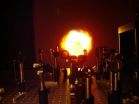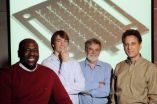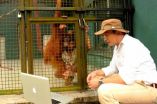(Press-News.org) As homeowners we are becoming cannier about turning down the thermostat to save our pennies and the planet but are we as energy conscious when we get to work?
A new £1.3m project, being led by researchers at The University of Nottingham, is to look at people's attitudes to energy consumption in the workplace and how to encourage colleagues to work together in reducing their organisation's carbon footprint.
Drawing on technical expertise at Nottingham's Horizon Digital Economy Research and design skills of experts at The University of Southampton, the five-year study will also aim to deliver new 'energy display' technologies that will allow workers to visualise their energy use and potentially identify areas where further savings could be made.
Project lead, Dr Alexa Spence said: "Obviously at home there is a financial incentive to save energy as well as what's termed the 'warm glow' environmental and moral imperative. We want to find out whether these incentives still apply when people reach their place of work and to look at which strategies are most successful in encouraging people to engage with their energy use."
The research, funded by the Engineering and Physical Sciences Research Council (EPSRC), will see the academics collaborating with industry experts including Arup and WilSon Energy, who conduct energy monitoring for companies and provide energy efficiency solutions to reduce companies' costs and their impact on the environment.
The researchers will be given access to some of the consultants' client base which will allow them to find out what workers are already doing to save energy, what would encourage them to be more energy efficient and decide the best way of motivating the workforce to make further savings.
Dr Spence said: "Energy is invisible and we often don't think about it. When we go to work we don't go there with the specific aim of using energy, we are far too busy thinking about doing our job. We are not the bill payer, so there is not much incentive for us to make an effort to be more energy efficient. The challenge is how to incentivise people to want to save energy."
The Nottingham team, which includes sociologists and psychologists, will also be looking at how the workforce might prefer to effect change, either individually or part of a team and, if so, the best ways to encourage people to work together. They will be asking how companies can best inspire staff to take part in energy saving initiatives and how to sustain their enthusiasm and cooperation in the long-term.
Dr Spence added: "Firstly we need to know what workers have the power to change themselves and which things, for example the lighting or the building's heating, might be out of their control. We would like to promote organisational change by motivating the staff to ask constructive questions, for example, why do the lights need to be left on all night?"
The project will lead to the development of a 'toolkit' that they will test among staff at companies that are currently having their energy use monitored to establish whether it is successful in having an impact. This will encompass guidance on developing workplace initiatives as well as technical advice and design prototypes that can be installed to monitor energy use in new and engaging ways.
The resulting 'toolkit' will be rolled out to other companies with assistance from the Centre for Sustainable Energy (CSE), an independent national charity that aims to help people and organisations from the public, private and voluntary sectors to meet the twin challenges of rising energy costs and climate change.
###
Horizon is a research institute at The University of Nottingham engaged in digital economy research. Established in 2009, it represents an initial £40 million investment by Research Councils UK (RCUK), The University of Nottingham and more than 100 academic and industrial partners in both a Research Hub and Doctoral Training Centre within the RCUK Digital Economy programme.
Further information on the project is available on the web at www.energyforchange.ac.uk
An energy conscious workforce: New research looks at how to encourage staff to go green
2012-11-27
ELSE PRESS RELEASES FROM THIS DATE:
Study suggests different organ-derived stem cell injections improve heart function
2012-11-27
Putnam Valley, NY. (Nov. 27, 2012) – A study published in the current issue of Cell Transplantation (21:8), now freely available on-line at http://www.ingentaconnect.com/content/cog/ct/, has found that when mesenchymal cells derived from skeletal muscle (SM-MSCs) or adipose tissue (ADSCs) were injected into the heart muscle (myocardium) of separate groups of laboratory rats that had suffered a myocardial infarction, rats in both groups experienced significantly improved left ventricle function and smaller infarct size after cell therapy.
The study, carried out by researchers ...
Tracking pollution from outer space
2012-11-27
The thickest layers of global smog — caused by traffic, industry, and natural minerals, among other factors — are found over the world's megacities. But getting an accurate measurement of pollution is no easy task. On-the-ground monitoring stations do not always provide the most accurate picture —monitoring stations depend heavily on local positioning and some cities put stations in urban centers, while others build on the edge of a city.
Now Prof. Pinhas Alpert of Tel Aviv University's Department of Geophysics and Planetary Sciences and head of the Porter School of Environmental ...
Illuminating the no-man's land of waters' surface
2012-11-27
Water repelling molecules are said to be hydrophobic. The hydration – or formation of water interfaces around hydrophobic molecules – is important for many biological processes: protein folding, membrane formation, transport of proteins across an interface, the transmission of action potentials across membranes. It is involved as well in the process of creating mayonnaise, or in the fact that you can get rid of fat with soap. Hydrophobic interfaces although long studied, are poorly understood.
Here's an amusing kitchen-table experiment to illustrate waters unusual properties: ...
Measles vaccine given with a microneedle patch could boost immunization programs
2012-11-27
Measles vaccine given with painless and easy-to-administer microneedle patches can immunize against measles at least as well as vaccine given with conventional hypodermic needles, according to research done by the Georgia Institute of Technology and the Centers for Disease Control and Prevention (CDC).
In the study, the researchers developed a technique to dry and stabilize the measles vaccine – which depends on a live attenuated virus – and showed that it remained effective for at least 30 days after being placed onto the microneedles. They also demonstrated that the ...
Safer spinach? Scientist's technique dramatically reduces E. coli numbers
2012-11-27
URBANA – University of Illinois scientists have found a way to boost current industry capabilities when it comes to reducing the number of E. coli 0157:H7 cells that may live undetected on spinach leaves.
"By combining continuous ultrasound treatment with chlorine washing, we can reduce the total number of foodborne pathogenic bacteria by over 99.99 percent," said Hao Feng, a U of I professor of food science and human nutrition.
According to Feng, the USDA is looking for proposed technologies that can achieve a 4 to 6 log reduction in pathogen cells (a 6 log reduction ...
'Walking on marbles' could be a thing of the past for arthritis patients
2012-11-27
Researchers at the University of Southampton are to undertake a new stage of a study aimed at improving the health and mobility of those suffering from the common complaint of 'walking on marbles' associated with Rheumatoid Arthritis (RA) in the feet.
RA is the second most common form of arthritis in the UK, affecting almost 600,000 people, which results in the destruction of joints around the body caused by inflammation.
Forefeet often contain some of the first joints to be affected and those with the condition often say that they feel like they are 'walking on marbles'. ...
Seeing the world through the eyes of an Orangutan
2012-11-27
She is a captive bred Sumatran orangutan. He is a neuroscientist specialising in cognitive and sensory systems research. With the help of specially adapted eye tracking equipment they are hoping to explain some of the mysteries of the visual brain and improve the lives of captive bred animals.
Dr Neil Mennie, from The University of Nottingham Malaysia Campus (UNMC), has received funding from Ministry of Science and Technology and Innovation, Malaysia (MOSTI) to study the eye movements of Tsunami — a seven year old orangutan at The National Zoo of Malaysia (Zoo Negara). ...
Gene linked to respiratory distress in babies
2012-11-27
Some infants are more susceptible to potentially life-threatening breathing problems after birth, and rare, inherited DNA differences may explain why, according to research at Washington University School of Medicine in St. Louis.
The study is the first to identify a single gene — ABCA3 — that is associated with a significant number of cases of respiratory distress syndrome (RDS) in babies born at or near full term. RDS is the most common respiratory problem in newborns and the most common lung-related cause of death and disease among U.S. infants less than a year old.
Their ...
The installed price of solar photovoltaic systems in the US continues to decline at a rapid pace
2012-11-27
Berkeley, CA — The installed price of solar photovoltaic (PV) power systems in the United States fell substantially in 2011 and through the first half of 2012, according to the latest edition of Tracking the Sun, an annual PV cost-tracking report produced by the Department of Energy's Lawrence Berkeley National Laboratory (Berkeley Lab).
The median installed price of residential and commercial PV systems completed in 2011 fell by roughly 11 to 14 percent from the year before, depending on system size, and, in California, prices fell by an additional 3 to 7 percent within ...
Topical simvastatin shown to accelerate wound healing in diabetes
2012-11-27
Philadelphia, PA, November 27, 2012 – Delayed wound healing is a major complication of diabetes because the physiological changes in tissues and cells impair the wound healing process. This can result in additional disease outcomes such as diabetic foot ulcer, a significant cause of morbidity in the growing population of diabetic patients. A new study has found that topically applied simvastatin accelerates wound healing in diabetic mice, suggesting important implications for humans with diabetes. This study is published in the December issue of The American Journal of ...


